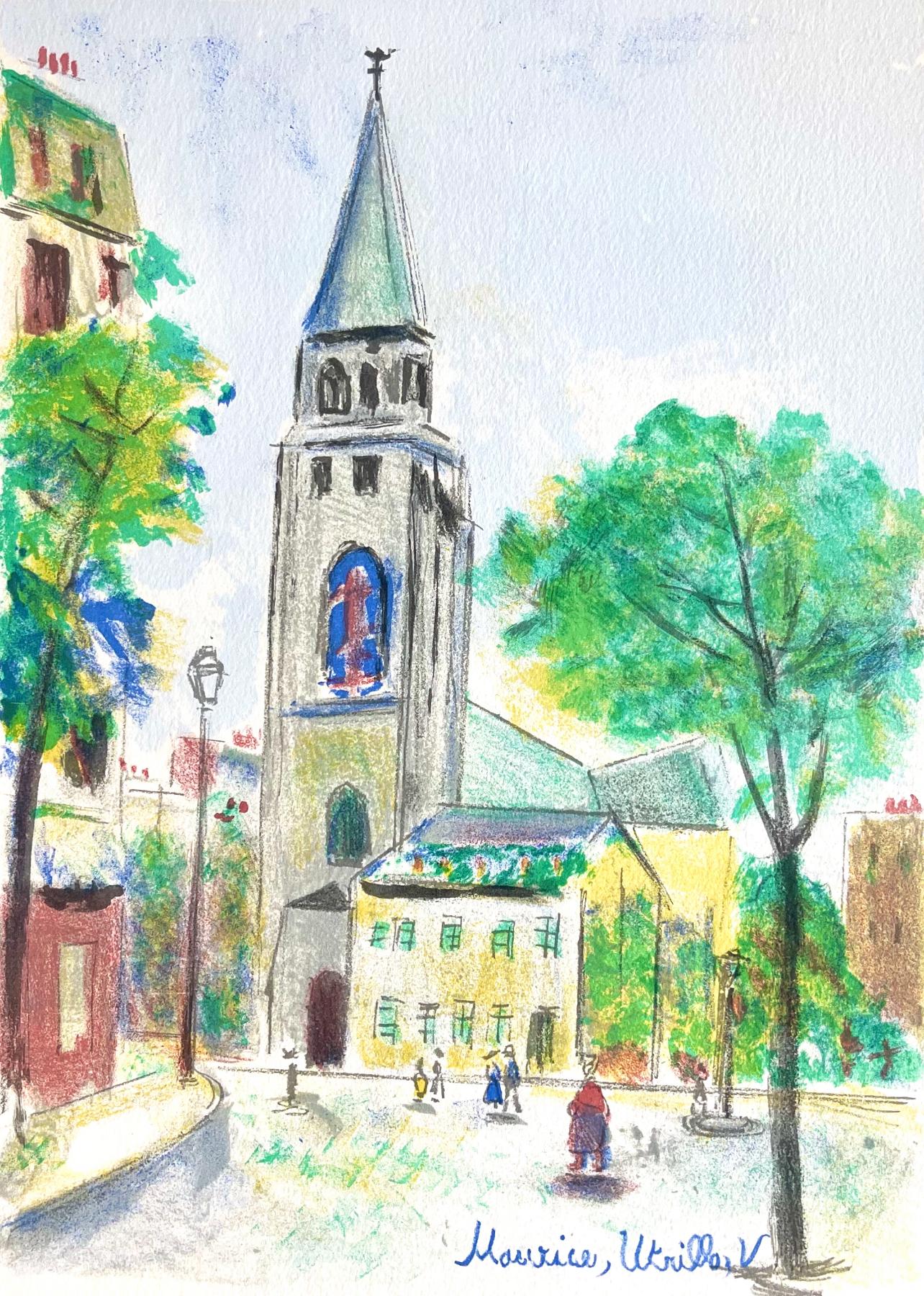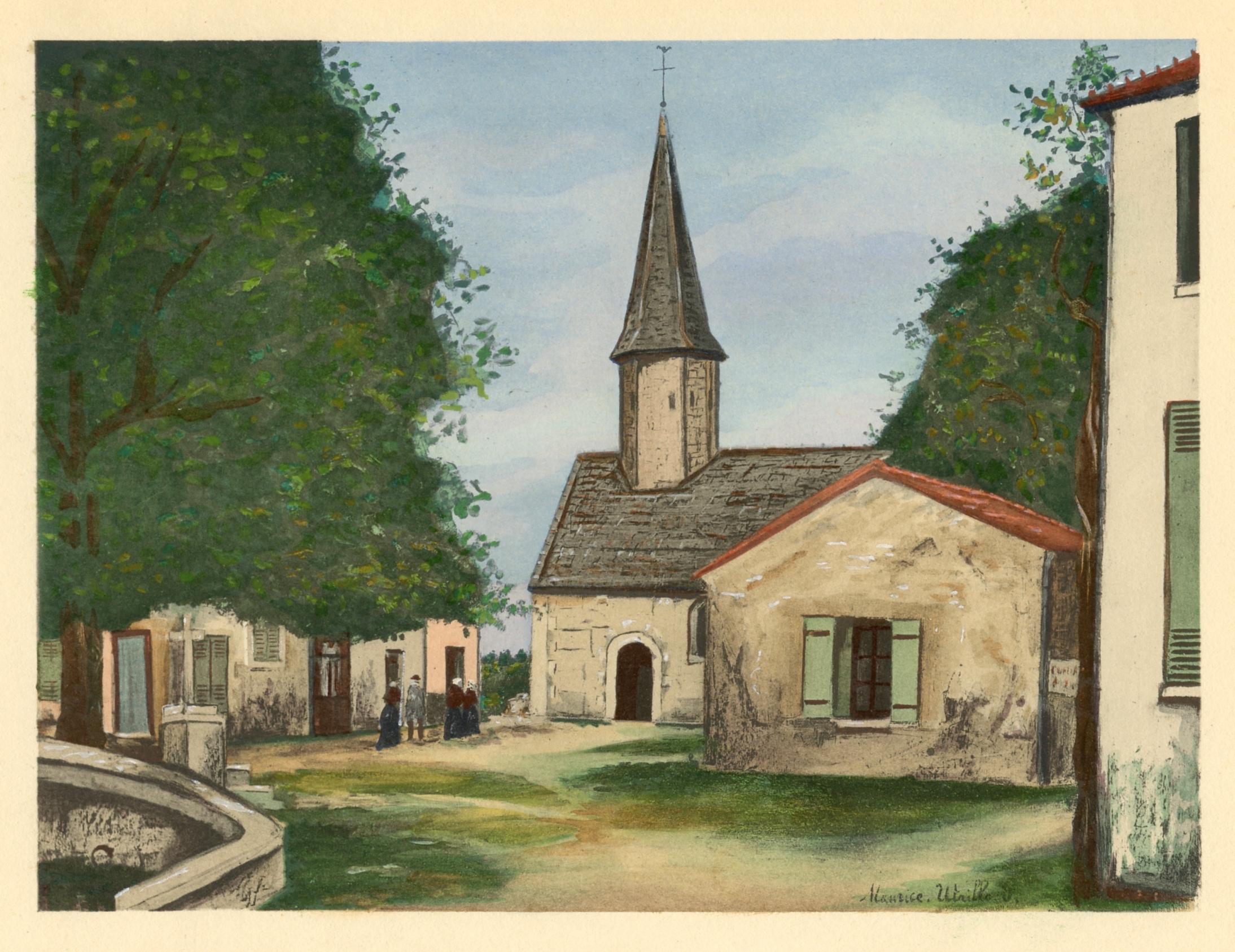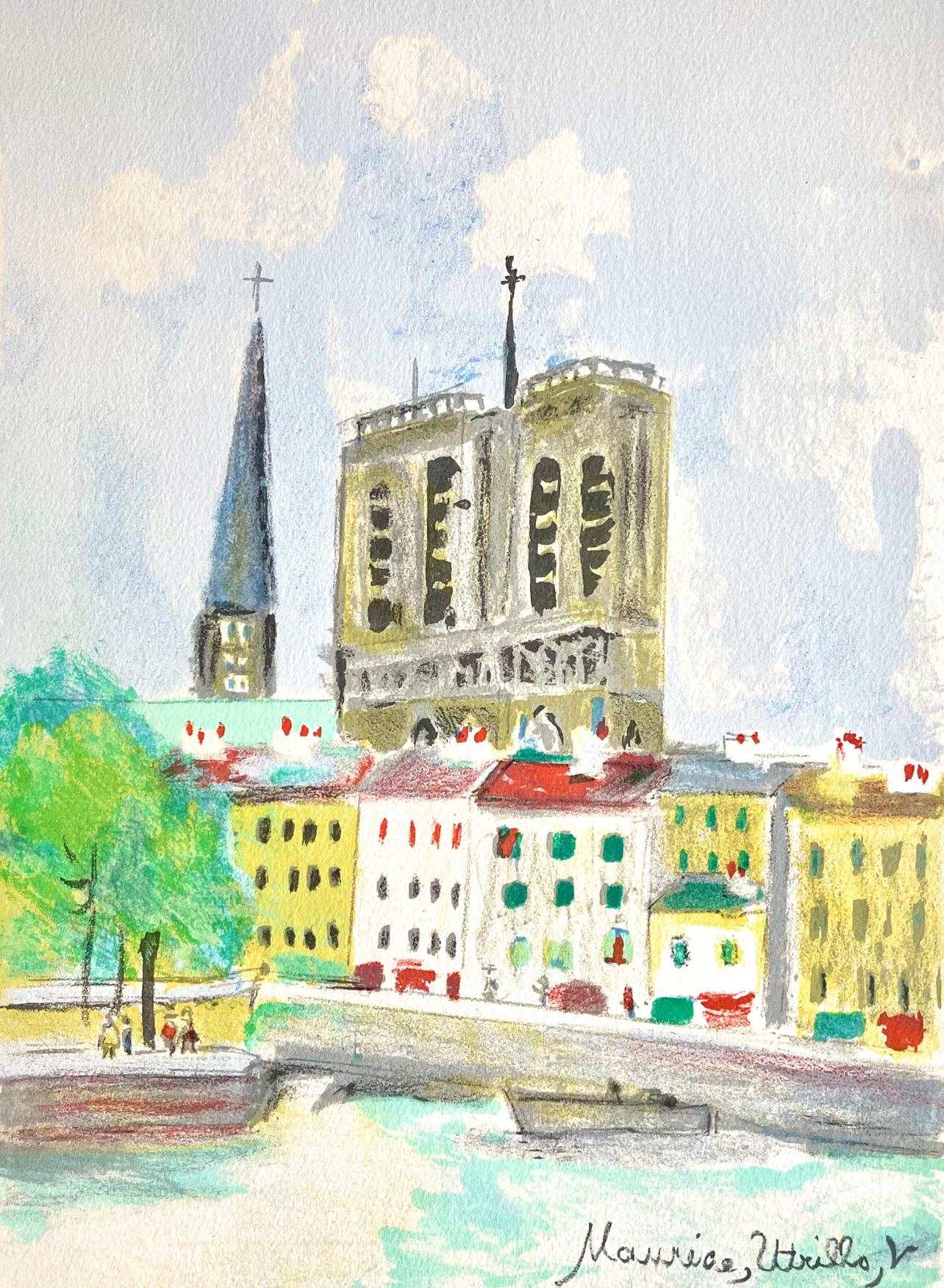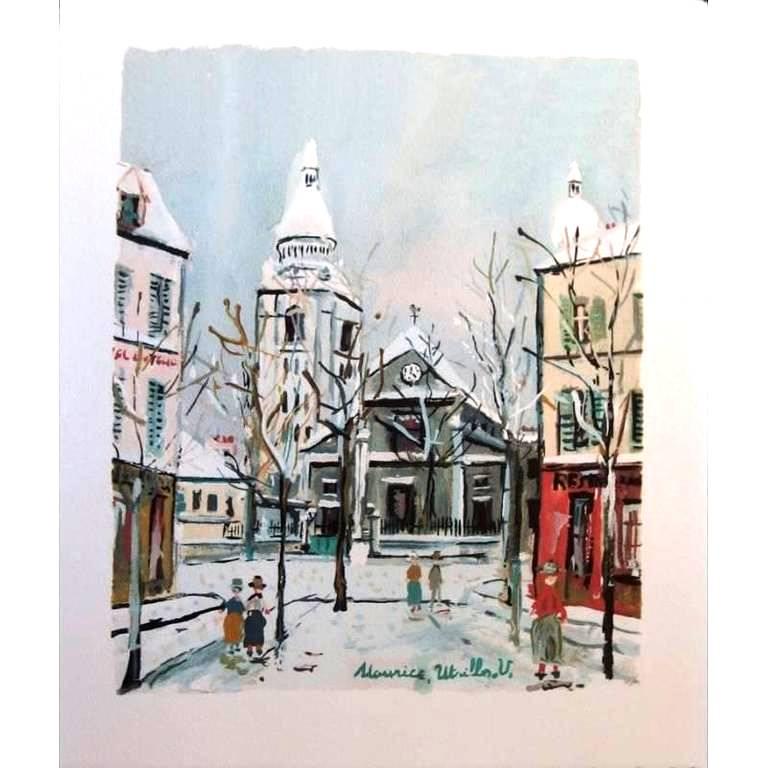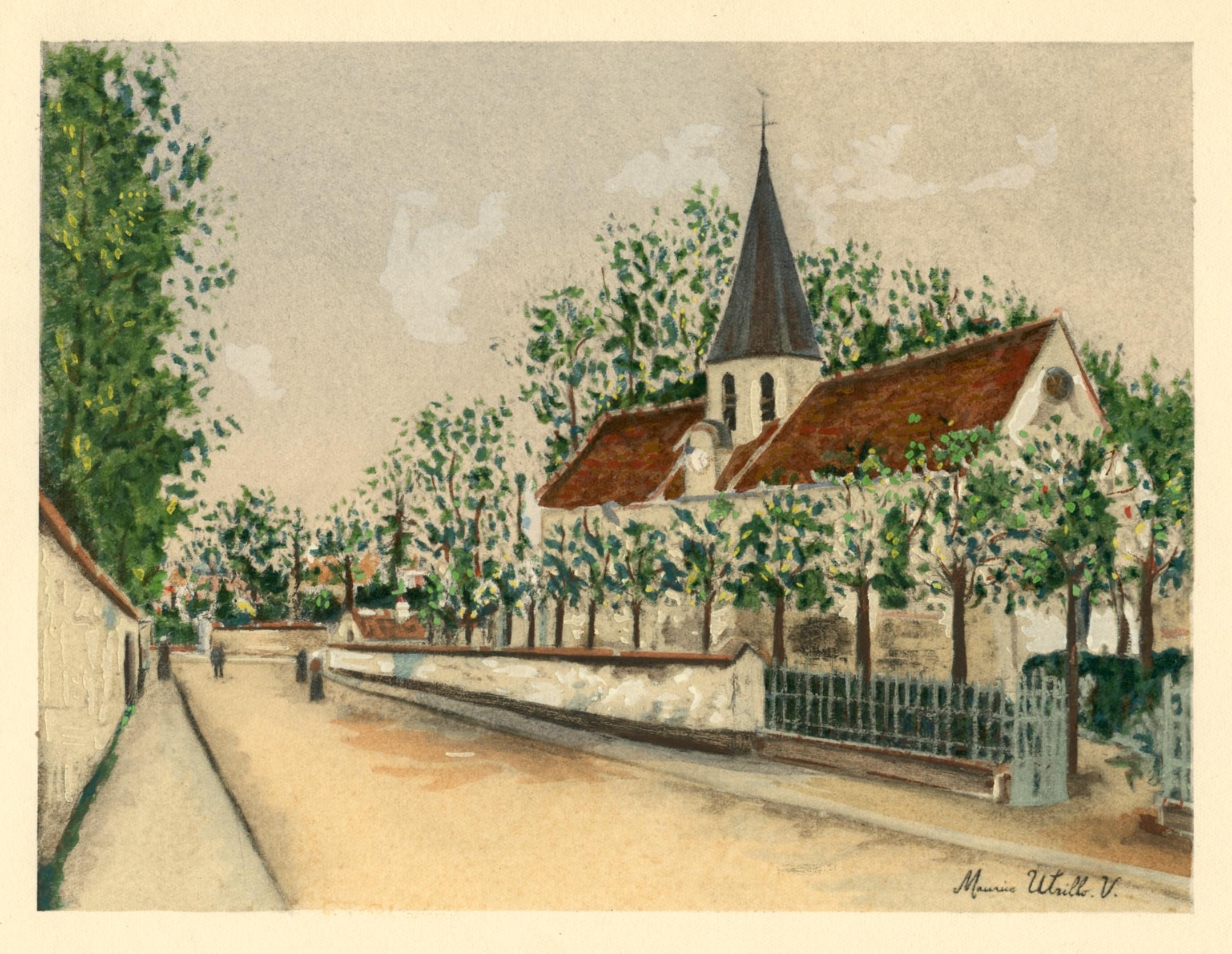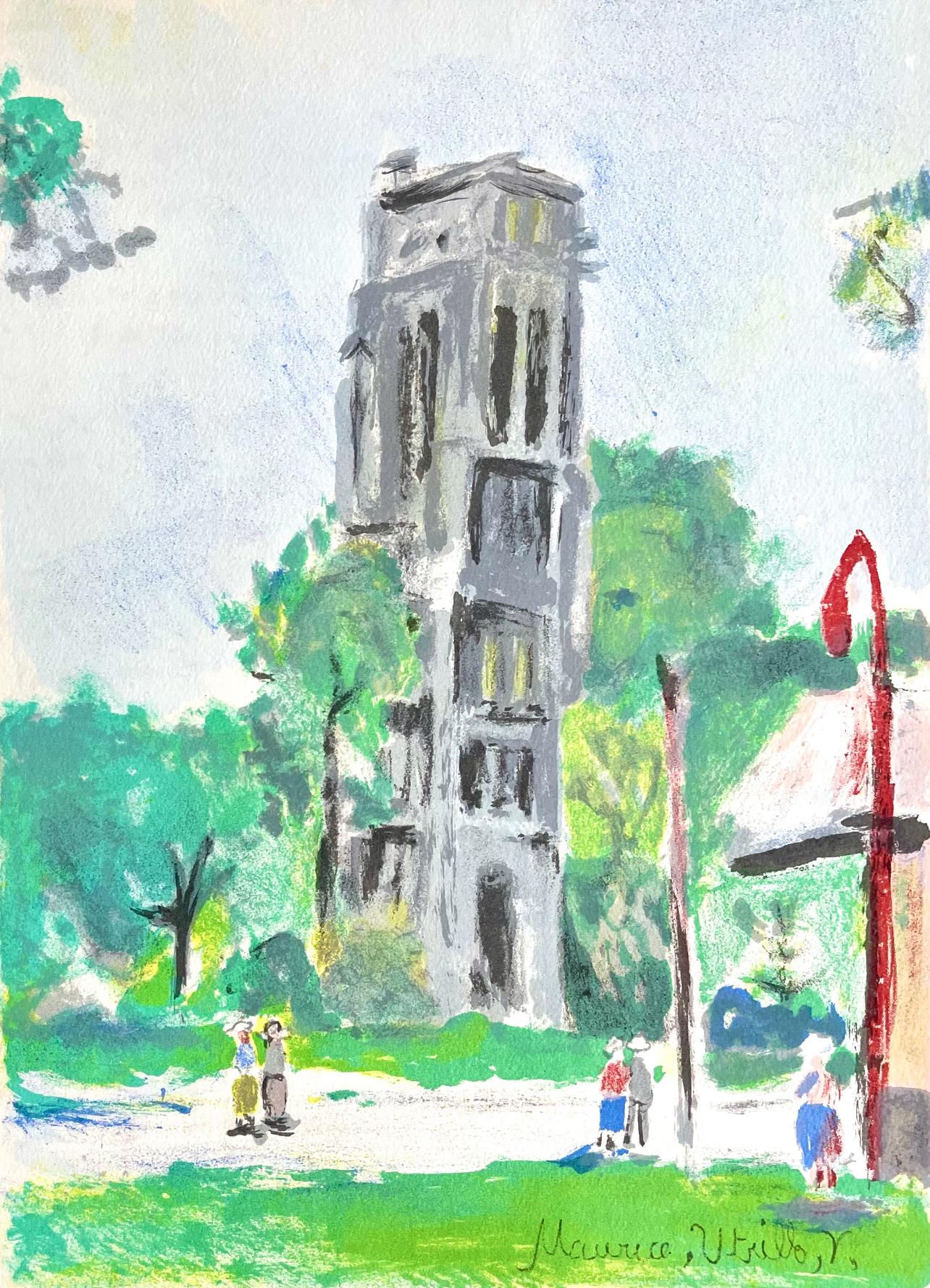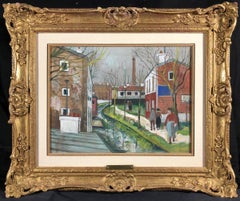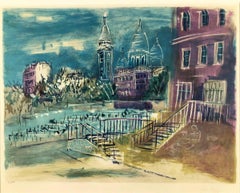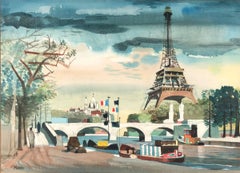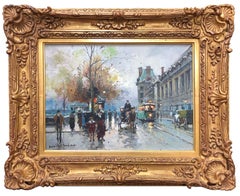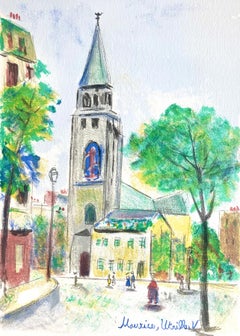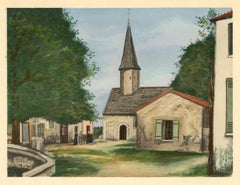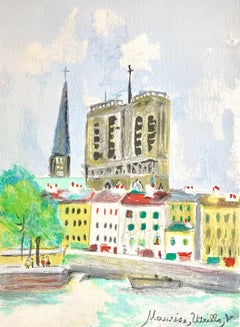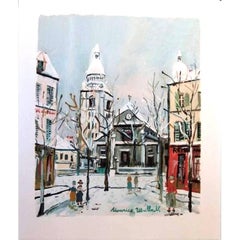Items Similar to L'Eglise
Want more images or videos?
Request additional images or videos from the seller
1 of 10
Maurice UtrilloL'Eglise1937
1937
Price Upon Request
Price Upon Request
Price Upon Request
Price Upon Request
Price Upon Request
Price Upon Request
Price Upon Request
Price Upon Request
Price Upon Request
Price Upon Request
About the Item
Maurice Utrillo (1883-1955)
"L'Eglise" (Petrides No 25.562)
Created 1937
Signed and Dated Lower Right
Without Frame: 11" x 8.75"
With Frame: 21" x 17.5"
Provenance: Galerie Gilbert & Paul Petrides, Paris
*This work has been authenticated and is included in the catalogue raisonne by Gilbert & Paul Petrides. See included photo-certificate.
Maurice Utrillo, initially Maurice Valadon, was born in Paris, December 26, 1883, the illegitimate son of the artist Suzanne Valadon. She, who had become a model after a fall from a trapeze, ended her chosen career as a circus acrobat, found that posing for Berthe Morisot, Pierre-Auguste Renoir, Henri de Toulouse-Lautrec and others provided her with an opportunity to study their techniques; in some cases, she had also become their mistress. She taught herself to paint, and when Toulouse-Lautrec introduced her to Edgar Degas, he became her mentor. Eventually she became a peer of the artists she had posed for.
Meanwhile, Valedon's mother was left in charge of raising the young Utrillo, who soon showed a troubling inclination toward truancy and alcoholism. When a mental illness took hold of the twenty-one year old Utrillo in 1904, he was encouraged to paint by his mother. Under her tutelage, he began painting the streets of his childhood neighborhood, Montmartre. Working in the tradition of the conventional veduta, he depicted streets, buildings, fountains, and avenues, which he captured at different seasons of the year in a style influenced by the lyrical realism of Camille Pissarro and Albert Sisley. However, by deploying a subtle palette - mainly yellows, turquoise, maroon and zinc white - he suffused the scenes with atmospheric* qualities that evoke feelings either of familiarity or of alienation in the viewer.
Known as his 'White Period' (période blanche), the years between 1909 and 1914 represent the acme of Utrillo's creativity. During this time, he reduced his palette to white, shading into grays. He also mixed his paints with sand, plaster, and lime to render the physical substance of his subject matter, walls in particular. In 1910, art critics F. Jourdan and E. Faure discovered the artist. Their appreciation of his talent enabled Utrillo to take part for the first time in the 1912 Salon d'Automne*. Until 1914, Utrillo traveled in Brittany and Corsica; his works assumed an increasingly luminous* quality, which greatly enriched his earlier ascetic conception of reality. In 1924, he exhibited with his mother at the Galerie Bernheim-Jeune in Paris and was offered a contract for a year. However, that same year he also attempted to commit suicide, which was probably the result of years of alcohol abuse.
A powerful natural talent, Utrillo made an enormous contribution in consolidating painterly structure and texture. He was also important as a draughtsman*. In 1926, he designed stage scenery and costumes for Djaghilev's Ballets Russes. He received public recognition in 1928, when he was made a member of the Legion of Honour.
Starting where Impressionism* left off, Utrillo became the best-known portrayer of Paris, especially Montmartre, painting both from nature and from postcards. His poetic interpretations of the streets and squares of Montmartre contributed substantially to popularizing a romantic image of that quarter. However, when he painted people, they were always represented as solitary beings, lost in social isolation. The first comprehensive retrospective of Utrillo's work was held at the 1943 Salon d'Automne.
- Creator:Maurice Utrillo (1883 - 1955, French)
- Creation Year:1937
- Dimensions:Height: 11 in (27.94 cm)Width: 8.75 in (22.23 cm)
- Medium:
- Movement & Style:
- Period:
- Condition:
- Gallery Location:Missouri, MO
- Reference Number:1stDibs: LU747310220092
Maurice Utrillo
Maurice Utrillo, initially Maurice Valadon, was born in Paris, December 26, 1883, the illegitimate son of the artist Suzanne Valadon. She, who had become a model after a fall from a trapeze, ended her chosen career as a circus acrobat, found that posing for Berthe Morisot, Pierre-Auguste Renoir, Henri de Toulouse-Lautrec and others provided her with an opportunity to study their techniques; in some cases, she had also become their mistress. She taught herself to paint, and when Toulouse-Lautrec introduced her to Edgar Degas, he became her mentor. Eventually she became a peer of the artists she had posed for. Meanwhile, Valedon's mother was left in charge of raising the young Utrillo, who soon showed a troubling inclination toward truancy and alcoholism. When a mental illness took hold of the twenty-one year old Utrillo in 1904, he was encouraged to paint by his mother. Under her tutelage, he began painting the streets of his childhood neighborhood, Montmartre. Working in the tradition of the conventional veduta, he depicted streets, buildings, fountains, and avenues, which he captured at different seasons of the year in a style influenced by the lyrical realism of Camille Pissarro and Albert Sisley. However, by deploying a subtle palette - mainly yellows, turquoise, maroon and zinc white - he suffused the scenes with atmospheric* qualities that evoke feelings either of familiarity or of alienation in the viewer. Known as his 'White Period' (période blanche), the years between 1909 and 1914 represent the acme of Utrillo's creativity. During this time, he reduced his palette to white, shading into grays. He also mixed his paints with sand, plaster, and lime to render the physical substance of his subject matter, walls in particular. In 1910, art critics F. Jourdan and E. Faure discovered the artist. Their appreciation of his talent enabled Utrillo to take part for the first time in the 1912 Salon d'Automne*. Until 1914, Utrillo traveled in Brittany and Corsica; his works assumed an increasingly luminous* quality, which greatly enriched his earlier ascetic conception of reality. In 1924, he exhibited with his mother at the Galerie Bernheim-Jeune in Paris and was offered a contract for a year. However, that same year he also attempted to commit suicide, which was probably the result of years of alcohol abuse. A powerful natural talent, Utrillo made an enormous contribution in consolidating painterly structure and texture. He was also important as a draughtsman*. In 1926, he designed stage scenery and costumes for Djaghilev's Ballets Russes. He received public recognition in 1928, when he was made a member of the Legion of Honour. Starting where Impressionism* left off, Utrillo became the best-known portrayer of Paris, especially Montmartre, painting both from nature and from postcards. His poetic interpretations of the streets and squares of Montmartre contributed substantially to popularizing a romantic image of that quarter. However, when he painted people, they were always represented as solitary beings, lost in social isolation.
About the Seller
5.0
Vetted Professional Seller
Every seller passes strict standards for authenticity and reliability
Established in 1970
1stDibs seller since 2017
155 sales on 1stDibs
Typical response time: 1 to 2 days
- ShippingRetrieving quote...Shipping from: Missouri, MO
- Return Policy
Authenticity Guarantee
In the unlikely event there’s an issue with an item’s authenticity, contact us within 1 year for a full refund. DetailsMoney-Back Guarantee
If your item is not as described, is damaged in transit, or does not arrive, contact us within 7 days for a full refund. Details24-Hour Cancellation
You have a 24-hour grace period in which to reconsider your purchase, with no questions asked.Vetted Professional Sellers
Our world-class sellers must adhere to strict standards for service and quality, maintaining the integrity of our listings.Price-Match Guarantee
If you find that a seller listed the same item for a lower price elsewhere, we’ll match it.Trusted Global Delivery
Our best-in-class carrier network provides specialized shipping options worldwide, including custom delivery.More From This Seller
View AllLes Usines En Banlieue
By Maurice Utrillo
Located in Missouri, MO
"Les Usines En Banlieue" 1926
Gouache
31 x 40cm/approx. 12.5 x 16.75 inches
Signed and Dated Lower Right
Catalogue Raisonne: Petredies, Plate AG166, Page 190-191
Category
1920s Impressionist Landscape Drawings and Watercolors
Materials
Gouache
Price Upon Request
Montmartre at Sacre Coeur
By Jean Dufy
Located in Missouri, MO
Jean Dufy
"Montmartre et La Basilique du Sacre Coeur" c. 1950s
Color Lithograph
Signed in Pencil Lower Right
Numbered 78/250 Lower Left
Image Size: approx...
Category
1950s Impressionist Landscape Prints
Materials
Lithograph
Price Upon Request
Paris and the Eiffel Tower (The City of Love)
By Dong Kingman
Located in Missouri, MO
This is by the great and legendary artist, Dong Kingman (1911-2000). See bio below.
Sheet Size: 22 x 30 inches
Signed
The following obituary is from Dong Kingman Jr., son of the artist:
DONG KINGMAN (1911-2000)
Dong Kingman, the world-renowned artist and teacher, died in his sleep on May 12, 2000 at age 89 in his home in Manhattan. The cause was pancreatic cancer.
Long acknowledged as an American watercolor master, he has received an extraordinary number of awards and honors throughout his 70-year career in the arts. Included are two Guggenheim fellowships in 1942 and 1943; the San Francisco Art Association First Purchase Prize, 1936; Audubon Artist Medal of Honor, 1946; Philadelphia Watercolor Club Joseph Pennel Memorial Medal, 1950; Metropolitan Museum of Art Award, and the National Academy Design 150th Anniversary Gold Medal Award, 1975.
In 1987, the American Watercolor Society awarded Dong Kingman its highest honor, the Dolphin Medal, "for having made outstanding contributions to art especially to that of watercolor."
His work is represented in the permanent collections of 50 museums and universities, including the Boston Museum of Fine Arts, M.H. deYoung Memorial Museum of Art, the Metropolitan Museum of Art, the Whitney Museum, Museum of Modern Art, Art Institute of Chicago, Pennsylvania Academy of Fine Arts, Sheldon Memorial Art Gallery and Sculpture Garden, Des Moines Art Center, Columbus Museum of Arts and Crafts, Brooklyn Museum and Hirshhorn Museum.
Born in Oakland, California in 1911 of Chinese descent, Kingman moved to Hong Kong at age five. He studied art and calligraphy in his formative years at the Lingnan School. The painting master Szeto Wai had recently studied art in Paris and took a keen interest in young Dongs precocious talents. He taught him both Chinese classical and French Impressionist styles of painting. Kingman returned home to Oakland when he was 18 at the height of the Depression. He worked as a newsboy and dishwasher to make ends meet.
When he was employed as a houseboy for the Drew family in San Francisco, he painted every spare moment. In a year, he created enough pictures to have a one-man show at the Art Center. It attracted the attention of San Francisco art critics who raved about Kingmans unique style. Wrote Junius Cravens of the San Francisco News: "That young Chinese artist is showing 20 of the freshest and most satisfying watercolors that have been seen hereabouts in many a day Kingman already has developed that universal quality which may place a sincere artist work above the limitations of either racial characteristics or schools. Kingmans art belongs to the world at large today." Dong Kingman became an overnight success.
From 1936 to 1941, he was a project artist for WPA and became a pioneer for a new school of painting, the "California Style." His two Guggenheim fellowships enabled him to travel the country painting American scenes. His first one-man show in New York at Midtown Galleries in 1942 was well received in the media, including Time, Newsweek, the New Yorker and American Artist. M.H. de Young Memorial Museum in San Francisco held a major exhibit of his watercolors in 1945.
In 1951, Midtown presented a 10-year retrospective of his work. Time Magazine wrote, "At age 40, Kingman is one of the worlds best watercolorists." Other retrospectives, including Corcoran in Washington,D.C. an d Witte Memorial Museum in San Antonio, were held for the artist. Kingman moved to Wildenstein (1958-1969) where he had successful exhibits in New York, London and Paris. Hammer Galleries exhibited his paintings in the 70s, and then the artist expanded his venues to the West Coast and Far East.
During World War II, he served with the OSS in Washington, D.C. where he was a cartographer. After his honorable discharge, Kingman moved to Brooklyn Heights from San Francisco when he became a guest lecturer and then art instructor at Columbia University (1946-1958). Hunter College also appointed him instructor in watercolors and Chinese Art (1948-1953). His teaching career continued with the Famous Artists School, Westport, CT in 1953, joining such distinguished artists on the faculty as Will Barnet, Stuart Davis, Norman Rockwell and Ben Shahn.
He also became a teaching member for 40 years for the Hewitt Painting Workshops, which conducts worldwide painting tours. He taught at the Academy of Art College in San Francisco, was a member of its board, and received an honorary doctorate from the Academy.
In 1954, the U.S. Department of State invited Kingman to go on a cultural exchange program tour around the world to give exhibitions and lectures and to meet local artists. When he came home, he presented the State Department with a 40-foot long report on a scroll, which later appeared in LIFE Magazine.
One of Kingman's most treasured experiences was his invitation by the Ministry of Culture of the Peoples Republic of China to exhibit in that country in 1981. He was the first American artist to be accorded a one-man show since diplomatic relations resumed. More than 100,000 visitors attended his exhibitions in Beijing, Hangzhou and Guangzhou and the retrospective received critical acclaim from the Chinese press. Noted the China Daily Mail, "Just as the master painters of the Song Dynasty roamed about mountain and stream to capture the rhythm of nature, Dong Kingman traveled the world capturing the dynamism of modern lifefamiliar scenes have been transformed into a vibrant new vision of life through color schemes with rhythms that play over the entire surface of the picture. The wind swept skies which enliven his watercolors remind us of the pleinairism of the French Impressionists."
Kingman, who has been fascinated with movies since seeing his first film "The Thief of Baghdad...
Category
1960s Modern Landscape Drawings and Watercolors
Materials
Watercolor
Price Upon Request
Quai de Louvre
By Antoine Blanchard
Located in Missouri, MO
Antoine Blanchard
"Quai de Louvre"
Oil on Canvas
Signed
Canvas Size: approx 13 x 18
Framed Size: approx. 22 x 26
Category
Mid-20th Century Post-Impressionist Landscape Paintings
Materials
Canvas, Oil
Price Upon Request
Bateau Sous la Pont
By Yolande Ardissone
Located in Missouri, MO
Bateau Sous la Pont
Yolande Ardissone (French, b. 1927)
Oil on Canvas
Signed Lower Center
30.25 x 25.25
31.5 x 36.5 inches with frame
Born in Normandy on June 6, 1927 to an Italian ...
Category
Late 20th Century Impressionist Landscape Paintings
Materials
Canvas, Oil
Price Upon Request
San Miguel, Mexico
By Dong Kingman
Located in Missouri, MO
San Miguel, Mexico
By Dong Kingman (American, 1911-2000)
Unframed: 22" x 15"
Framed: 31" x 24"
Signed Lower Left
Born in Oakland, CA on March 31, 1911. When Kingman was five, his family moved to Hong Kong where he grew up and attended Lingnan Grammar School. The headmaster of the school, Szetu Wei, had studied painting in Paris and recognized his budding artistic talent. For several years he trained young Kingman in both oriental and occidental approaches to painting. Returning to San Francisco in 1929, Kingman became active in the local art scene and began painting scenes of the city. His first solo show at the San Francisco Art Center in 1936 brought immediate recognition. During the 1930s he spent five years working on commissions for the Federal Public Works of Art Project. During WWII he created maps and charts for the O.S.S. After the war Kingman settled in NYC and taught at Columbia University. His paintings were used as backdrops for the movie "Flower Drum Song...
Category
20th Century American Modern Landscape Drawings and Watercolors
Materials
Watercolor
Price Upon Request
You May Also Like
Saint-Germain-des-Prés, Paris Capitale, Maurice Utrillo
By Maurice Utrillo
Located in Southampton, NY
Lithograph on vélin Johannot paper. Inscription: Unsigned and unnumbered. Good condition. Notes: From the folio, Paris Capitale, 1955; published by Joseph Foret, Editeur d'Art, Paris...
Category
1950s Modern Landscape Prints
Materials
Lithograph, Stencil
$4,396 Sale Price
20% Off
Free Shipping
"L'Eglise Sainte-Hilaire" pochoir
By (after) Maurice Utrillo
Located in Henderson, NV
Medium: pochoir (after the painting). Published in Paris in 1929 by Editions des Chroniques du Jour in an edition of 500. Image size: 6 1/2 x 8 1/2 inches (163 x 214 mm). With full o...
Category
1920s Prints and Multiples
Materials
Lithograph, Stencil
à Notre-Dame (La Cité), Paris Capitale, Maurice Utrillo
By Maurice Utrillo
Located in Southampton, NY
Lithograph on vélin Johannot paper. Inscription: Unsigned and unnumbered. Good condition. Notes: From the folio, Paris Capitale, 1955; published by Joseph Foret, Editeur d'Art, Paris...
Category
1950s Modern Landscape Prints
Materials
Lithograph, Stencil
$1,436 Sale Price
20% Off
Free Shipping
L'Eglise Saint Pierre de Montmartre - Pochoir
By (after) Maurice Utrillo
Located in Collonge Bellerive, Geneve, CH
(after) Maurice Utrillo
Title: L'Eglise Saint Pierre de Montmartre
Pochoir with printed signature
Edition of 550
Dimensions: 39 x 32 cm
Information : This print was created for the portfolio "Le Village inspiré, Chronique de la bohème de Montmartre (1920-1950) " published by Vertex in 1950
Condition : Excellent
Maurice Utrillo (1883 - 1955)
The French painter Maurice Utrillo was born as the illegitimate son of the painter Suzanne Valladon in Paris on December 26, 1883. He was adopted by the Catalan art critic Miguel Utrillo...
Category
1950s Modern Landscape Prints
Materials
Lithograph
"L'Eglise d'Eaubonne" pochoir
By (after) Maurice Utrillo
Located in Henderson, NV
Medium: pochoir (after the painting). Published in Paris in 1929 by Editions des Chroniques du Jour in an edition of 500. Image size: 6 1/4 x 8 1/2 inches (162 x 214 mm). With full o...
Category
1920s Prints and Multiples
Materials
Lithograph, Stencil
à la Comédie Française, Paris Capitale, Maurice Utrillo
By Maurice Utrillo
Located in Southampton, NY
Lithograph on vélin Johannot paper. Inscription: Unsigned and unnumbered. Good condition. Notes: From the folio, Paris Capitale, 1955; published by Joseph Foret, Editeur d'Art, Paris...
Category
1950s Modern Landscape Prints
Materials
Lithograph, Stencil
$4,396 Sale Price
20% Off
Free Shipping
